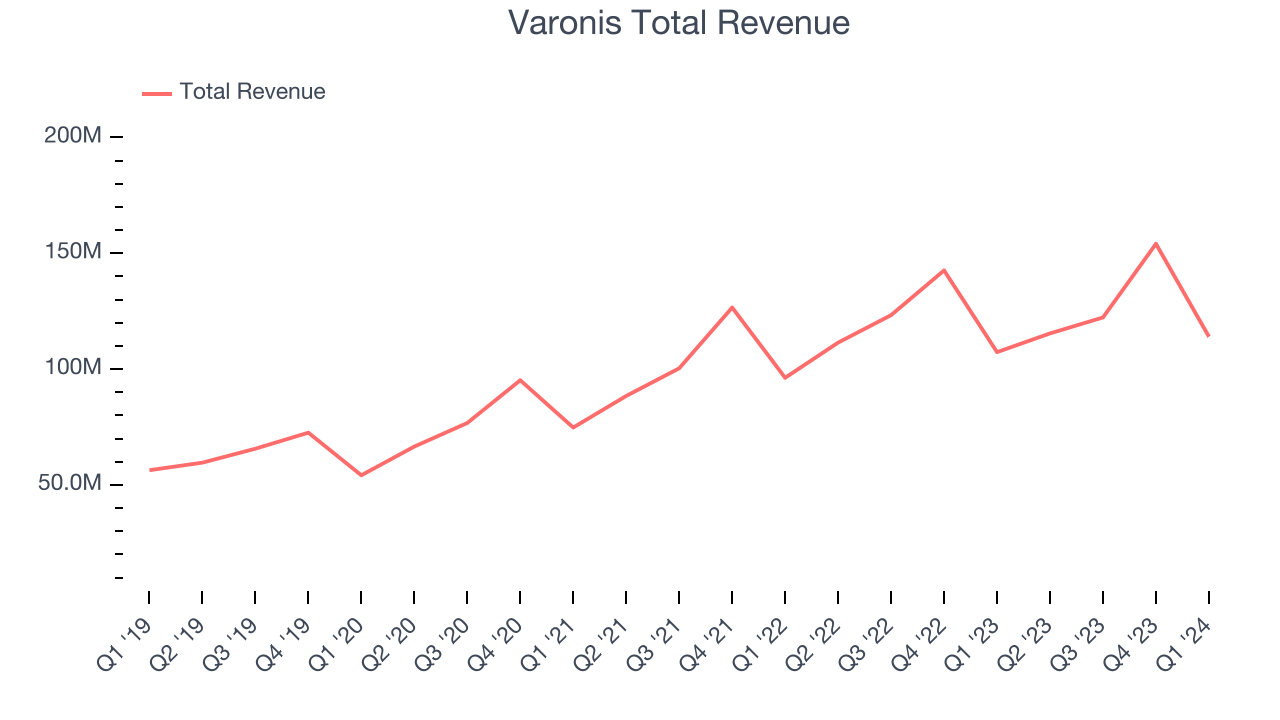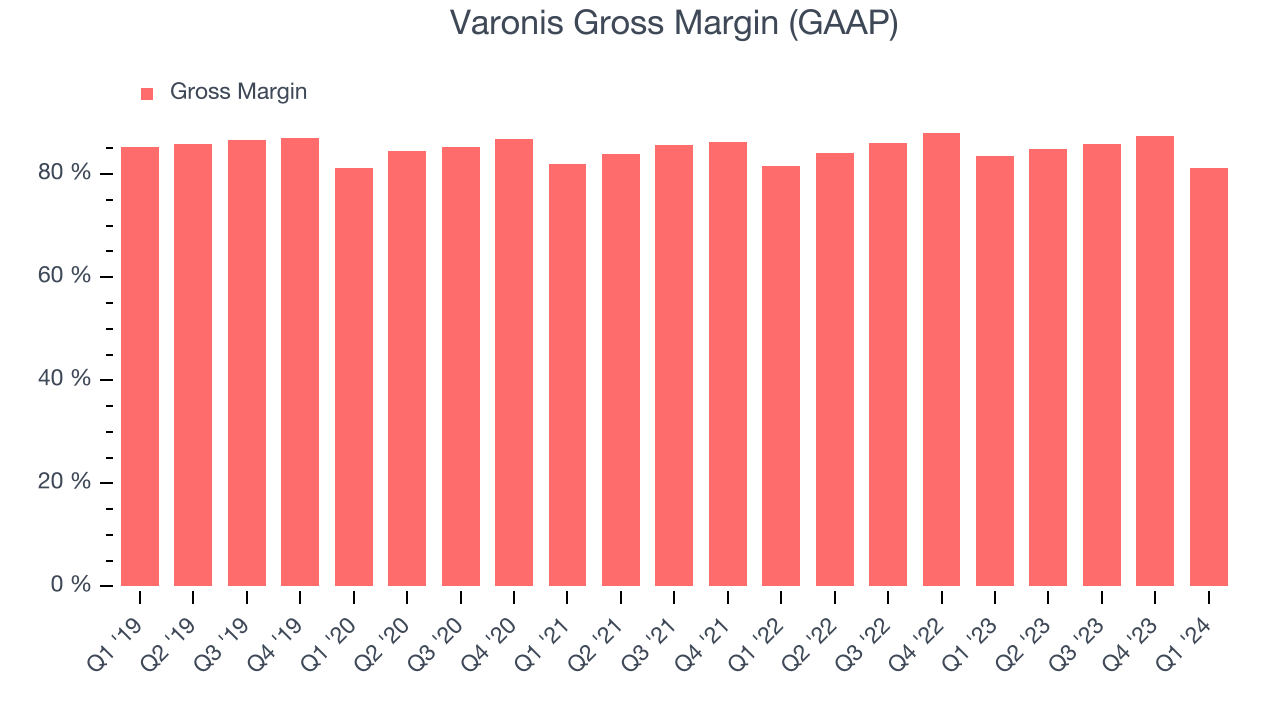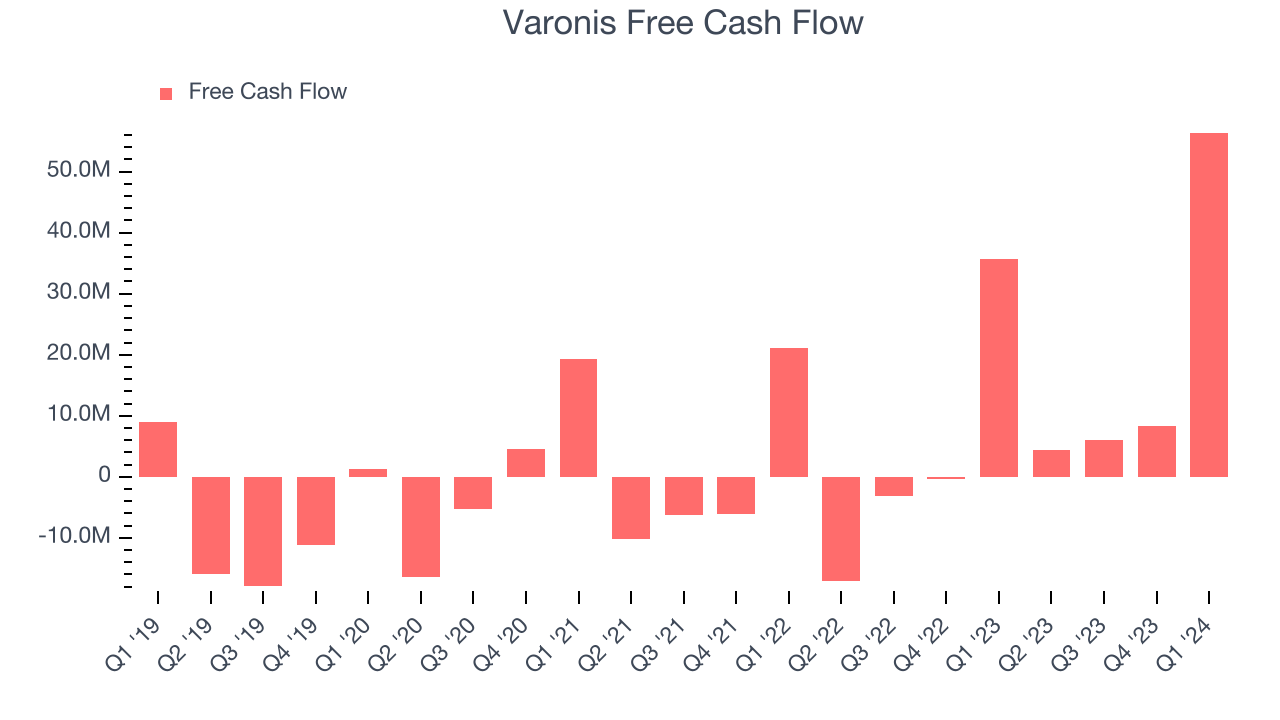Data protection and security software company Varonis (NASDAQ:VRNS) reported results in line with analysts' expectations in Q1 CY2024, with revenue up 6.2% year on year to $114 million. On the other hand, the company expects next quarter's revenue to be around $124.5 million, slightly below analysts' estimates. It made a non-GAAP loss of $0.03 per share, down from its loss of $0 per share in the same quarter last year.
Varonis (VRNS) Q1 CY2024 Highlights:
- Revenue: $114 million vs analyst estimates of $113.7 million (small beat)
- EPS (non-GAAP): -$0.03 vs analyst estimates of -$0.09 ($0.06 beat)
- Revenue Guidance for Q2 CY2024 is $124.5 million at the midpoint, below analyst estimates of $125.6 million (operating loss also guided to worse than expectations)
- The company reconfirmed its revenue guidance for the full year of $541 million at the midpoint (slightly raised full year operating profit guidance)
- Gross Margin (GAAP): 81.3%, down from 83.6% in the same quarter last year
- Free Cash Flow of $56.4 million, up from $8.29 million in the previous quarter
- Annual Recurring Revenue: $560.3 million at quarter end, up 17.2% year on year
- Market Capitalization: $4.78 billion
Founded by a duo of former Israeli Defense Forces cyber warfare engineers, Varonis (NASDAQ:VRNS) offers software-as-service that helps customers protect data from cyber threats and gain visibility into how enterprise data is being used.
The company's key product is the Varonis Data Security platform. It provides features including real-time threat detection, data classification/governance, and compliance reporting. Threat detection tells an organization if a rogue employee is moving large amounts of data. Data classification/governance helps organize data by levels of sensitivity and can automatically apply access and security measures based on this. Compliance reporting ensures that an organization’s data practices comply with regulations that may govern where consumer demographic data is stored, for example.
Without proper tools, organizations are generally better equipped to create data than protect it, and data breaches can have significant financial and reputational consequences. For example, international email marketing company Epsilon suffered a database hack in 2011 that affected 75 clients and was estimated to cost the company $3-4bn when factoring in direct costs, forensic audits, litigation, and lost business.
The company’s customers are of various industries but tend to be larger enterprises rather than small or medium-sized businesses with few employees and simple IT architectures. Varonis generates revenue through software licensing and maintenance fees. The company also offers professional services such as implementation and training to ensure customer success.
Endpoint Security
Almost every company is slowly finding itself becoming a technology company and facing cybersecurity risks. As the volume of internet enabled devices grows, every device that employees use to connect to business networks represents a potential risk. Endpoint security software enables businesses to protect devices (endpoints) that employees use for work purposes either on a network or in the cloud from cyber threats.
Competitors offering data protection and security software providers include Qualys (NASDAQ:QLYS), Rapid7 (NASDAQ:RPD), and F5 (NASDAQ:FFIV).Sales Growth
As you can see below, Varonis's revenue growth has been mediocre over the last three years, growing from $74.79 million in Q1 2021 to $114 million this quarter.

Varonis's quarterly revenue was only up 6.2% year on year, which might disappoint some shareholders. On top of that, the company's revenue actually decreased by $40.08 million in Q1 compared to the $31.79 million increase in Q4 CY2023. Regardless, we aren't too concerned because Varonis's sales seem to follow a seasonal pattern and management is guiding for revenue to rebound in the coming quarter.
Next quarter's guidance suggests that Varonis is expecting revenue to grow 7.9% year on year to $124.5 million, improving on the 3.6% year-on-year increase it recorded in the same quarter last year. Looking ahead, analysts covering the company were expecting sales to grow 10.1% over the next 12 months before the earnings results announcement.
Profitability
What makes the software as a service business so attractive is that once the software is developed, it typically shouldn't cost much to provide it as an ongoing service to customers. Varonis's gross profit margin, an important metric measuring how much money there's left after paying for servers, licenses, technical support, and other necessary running expenses, was 81.3% in Q1.

That means that for every $1 in revenue the company had $0.81 left to spend on developing new products, sales and marketing, and general administrative overhead. Despite its recent drop, Varonis still has an excellent gross margin that allows it to fund large investments in product and sales during periods of rapid growth and achieve profitability when reaching maturity.
Cash Is King
If you've followed StockStory for a while, you know that we emphasize free cash flow. Why, you ask? We believe that in the end, cash is king, and you can't use accounting profits to pay the bills. Varonis's free cash flow came in at $56.4 million in Q1, up 57.9% year on year.

Varonis has generated $75 million in free cash flow over the last 12 months, a decent 14.8% of revenue. This FCF margin stems from its asset-lite business model and gives it a decent amount of cash to reinvest in its business.
Key Takeaways from Varonis's Q3 Results
Sporting a market capitalization of $3.46 billion, Varonis is among smaller companies, but its more than $448.9 million in cash on hand and positive free cash flow over the last 12 months puts it in an attractive position to invest in growth.
Revenue missed, next quarter's revenue guidance was in line, but full year guidance was below expectations. However, billings in the quarter beat expectations. Adjusted operating profit guidance for next quarter and the full year were mixed like with revenue guidance, where the former was ahead but the latter was below. Overall, the results were mixed and could have been better. The company is down 4.1% on the results and currently trades at $30.18 per share.
Key Takeaways from Varonis's Q1 Results
It was good to see Varonis beat analysts' ARR (annual recurring revenue) expectations this quarter. It was also comforting to see the company reiterate its full year revenue guidance and slightly raise its operating profit guidance. On the other hand, its revenue and operating profit guidance for next quarter missed Wall Street's estimates. Overall, this was a mixed quarter for Varonis. The stock is flat after reporting and currently trades at $44.58 per share.
Is Now The Time?
Varonis may have had a mixed quarter, but investors should also consider its valuation and business qualities when assessing the investment opportunity.
We think Varonis is a good business. Although its revenue growth has been a little slower over the last three years, its impressive gross margins indicate excellent business economics.
Given its price-to-sales ratio of 8.8x based on the next 12 months, the market is certainly expecting long-term growth from Varonis. There are definitely a lot of things to like about Varonis, and looking at the tech landscape right now, it seems to be trading at a pretty compelling price.
Wall Street analysts covering the company had a one-year price target of $51.06 right before these results (compared to the current share price of $44.58), implying they see short-term upside potential in Varonis.
To get the best start with StockStory, check out our most recent Stock picks, and then sign up for our earnings alerts by adding companies to your watchlist here. We typically have the quarterly earnings results analyzed within seconds of the data being released. Especially for companies reporting pre-market, this often gives investors the chance to react to the results before everyone else has fully absorbed the information.
